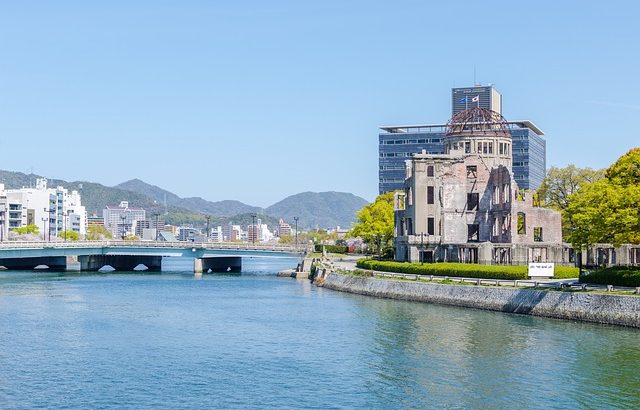When the first atomic bomb was dropped on Hiroshima on August 6, 1945, the city and the rest of the world changed forever. However, as devastating as this story was for the city, what rose from the ruins is an enduring memorial where lasting calls for peace continue to resonate today. To pay tribute to those who endured the widespread destruction on that ill-fated day, Hiroshima transformed the site into the global peace icon it is now known today — the Hiroshima Peace Memorial Park.
Situated right in the heart of Hiroshima, the park serves as a reminder of the dangers of war and a memorial to all who were affected by the bomb. As the very first city to have endured the very first nuclear attack, more than 200,000 people suffered when the United States dropped the first atomic bomb.
Today, the memorial park is an iconic destination, especially for people who want to glean into Japan’s tumultuous history. Every year, over a million people visit the site to pay their respects and honor its enduring legacy.
An anti-war memorial
Situated to the west of Hatchobori and Kamiyacho, Hiroshima Peace Memorial Park is right smack in downtown Hiroshima. Located in Nakajima, the park was once the city center. At the time of the bombing, it used to be home to around 6,500 people.
While not the intended target for the bomb, Nakajima was closest to the Aioibashi bride — the spot where the bomb was meant to be dropped. As Nakajima was closest to the bomb’s epicenter, it did not stand a chance against the explosion.
After the war ended, the city decided to preserve the ruins in the area where the park is now at. The intention was to create a memorial park for peace along with the calls to end nuclear warfare. With an area of 122,000 square meters, the park was officially opened in April 1954.
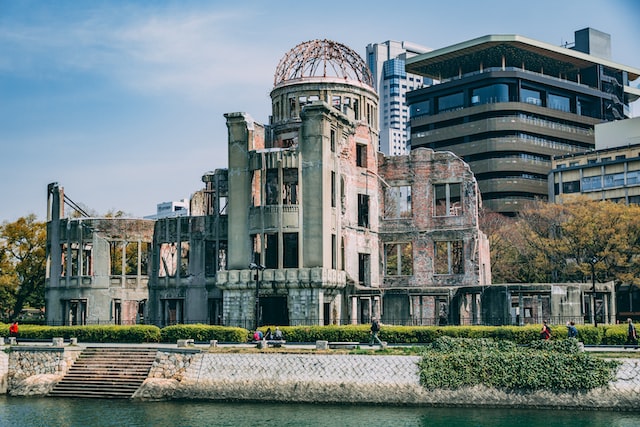
A glimpse of history
Back in the day, modern-day Hiroshima used to be a flourishing fishing village. Around the 12th century, they enjoyed lucrative trading with the rest of the country. It wasn’t until the 16th century, however, that the city was founded by Mori Terumoto, a powerful feudal lord. He is credited for building the iconic Hiroshima Castle.
The next three centuries saw the town controlled by several feudal lords. During the Meiji Restoration, Hiroshima became part of the new imperial domain. During this time, the country made a huge shift into becoming an industrial economy from its formerly agricultural one. Around this time, Hiroshima played a critical part as a military and transportation hub with the establishment of Ujina Port.
Through the years, the city flourished. There was even a time in 1894 when Hiroshima Castle served as a temporary setting for running the government. In World War II, however, after the city was blasted by an atomic bomb, the city’s historical legacy shifted. Upon rebuilding, it preserved certain parts of the city that were devastated by the bomb in the hopes that this will serve as a lasting reminder to the world of the consequences of war.
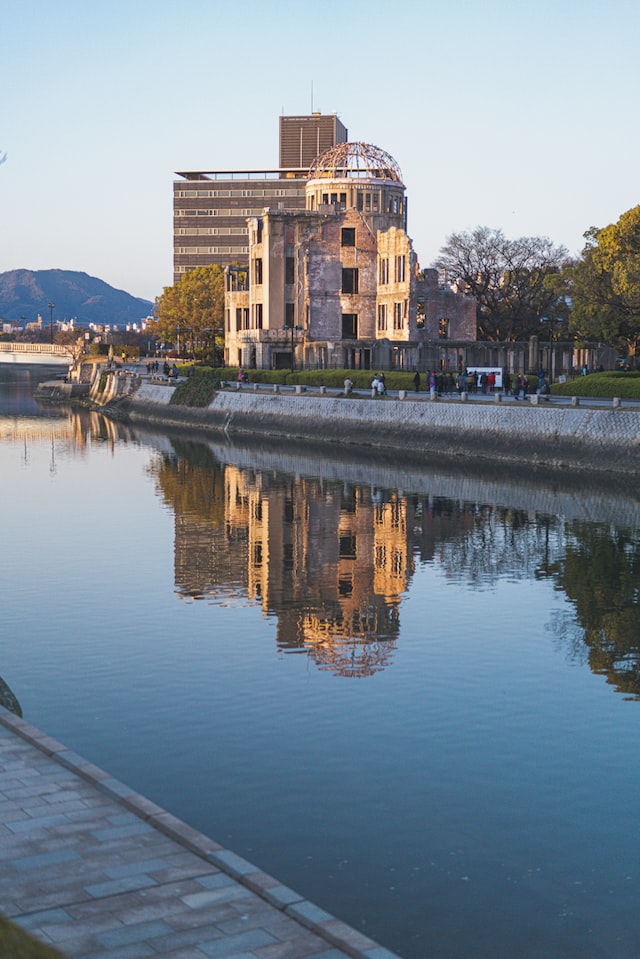
How the peace memorial came to be
Following the immediate aftermath of the nuclear blast, the survival of the atomic dome earned it the nickname “Genbaku Dome”. While there were remaining structures, most of the building was destroyed. As such, plans of demolishing the building were set. However, as plans to rebuild the city into a memorial of peace, people realized how important it is to preserve the ruins. As such, it was decided that it should form part of the peace memorial.
Around this time, the local government sought consultations from local and foreign resources on how to go about rebuilding the devastated city. Tam Deling, an American city planner, put in the idea of transforming the blast’s ground zero into the setting for the peace memorial. When the city announced a design competition in August 1949, the proposal by Kenzo Tange — a Japanese architect — was selected from 145 entries.
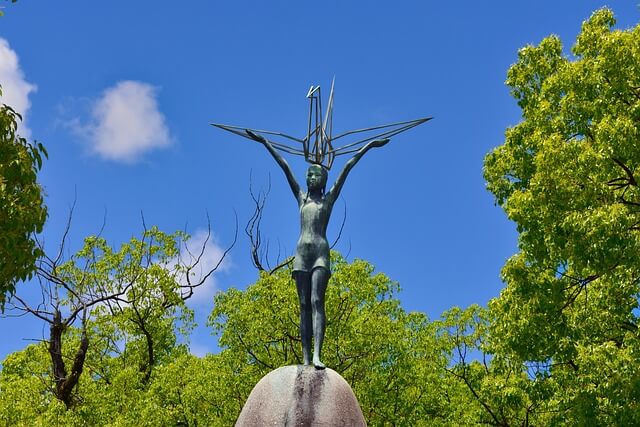
It took four years to construct Tange’s idea. The memorial opened in August 1955 with its first year seeing around 100,000 people visiting the site. As exhibits grew and the museum expanded, the number further increased to half a million by 1964. The site saw renovations in the 70s and the 90s to pave the way for enhanced exhibition technology and spaces. Today, the memorial serves as a reminder of the city’s commitment to calls for lasting peace.
The Cenotaph
One of the most popular attractions in the Hiroshima Peace Memorial Park is the Cenotaph. The curved concrete monument contains a list of all the names of the known victims of the atomic blast. Located at one end of the center pond in the park, it was designed to serve as a concrete frame for the Flame of Peace.
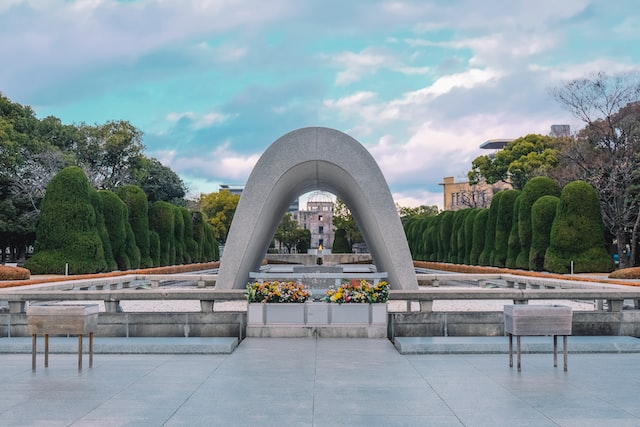
The Flame of Peace is a monument with actual burning flames that will continue to burn until the rest of the world gets rid of all of the nuclear weapons. Interestingly, the Cenotaph, the Flame of Peace, and the Atomic Bomb Dome were designed to align in a single straight line. Under the arch is a stone chest which is intended to represent the roof. The designers were inspired by haniwa pottery used as decoration for prehistoric tombs.
The Atomic Dome
Perhaps the most iconic structure in the park is the Atomic Dome. It’s especially notable how it has remained standing despite the horrific ordeal it went through. Its ruins serve as a stark reminder of the credibly devastating force caused by nuclear weapons. People look at it and are reminded of how destructive mankind can be. At the same time, it is a testament to humanity’s endurance and strength against the odds.
Before that fateful day in August 1945, the Atomic Dome used to be the Hiroshima Prefectural Commercial Exhibition Hall. Back then, it used to be the local market. Locals also use it for cinema screenings and art exhibitions. The structure was built in 1914 with its prominent dome-shaped roof made of copper. Its height and its striking design have already made it a renowned city symbol.
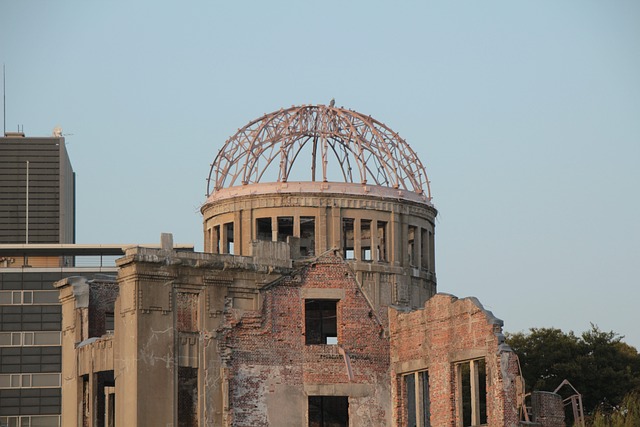
When the atomic bomb was dropped, it exploded around 600 meters above the dome. The hall’s earthquake-proof design meant that its metal framework and some outer walls withstood the blast. The inner structure and the copper dome, however, were not so lucky. While the rest of the city got leveled, the Atomic Dome remains the closest building to have survived the explosion.
Today, the Atomic Dome remains a striking spot along the Motoyasu River. Many people visiting the area often take a walk across the river at sunset to get a dramatic glimpse of the structure along with the setting sun. In 1996, UNESCO designated the landmark a World Heritage Site.
The memorial museum
People wanting to get more detailed information about the infamous bombing can check out the Hiroshima Peace Memorial Museum. Built by the city, the museum contains accurate pictures and records of the atomic attack. It details not only the immediate effects of the bombing but also the subsequent aftermath and how the victims suffered from the resulting radiation exposure.
One artifact not to be missed when visiting the museum is the pocket watch. Its hands stopped right at the very moment the bomb detonated over the city at 08:15. Events that discussed what took place before the war, during the war, and after can also be found here. Resources on the role that the city played during the Second World War are also available.
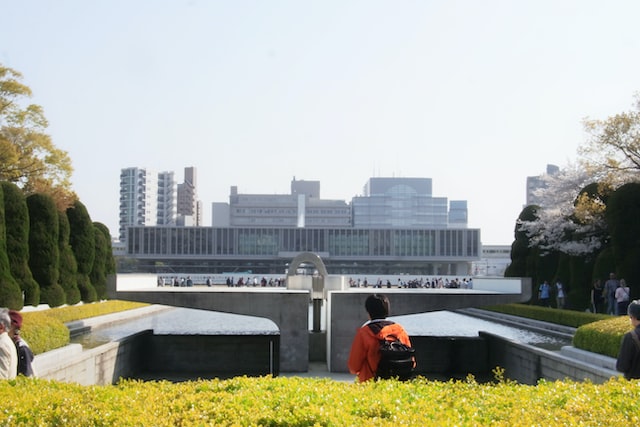
The Children’s Peace Monument
Another popular landmark in the park is the Children’s Peace Monument. The monument is dedicated to Sasaki Sadako, one of the children exposed to the radiation of the atomic blast. Sasaki was only two when she was exposed and later got diagnosed with leukemia as a result. She battled the disease before finally succumbing to the ailment after eight months.
While trying to recover from the condition, she made more than 1,000 origami cranes. The Japanese believe that making 1,000 of these paper cranes can have healing powers. With the papers used to wrap her medicines, Sasaki went on to make around 1,300 origamis. The memorial was erected to honor her memory 1958. Colorful paper planes in the thousands, made by Japanese school children and kids from all over the world can be seen surrounding the monument.
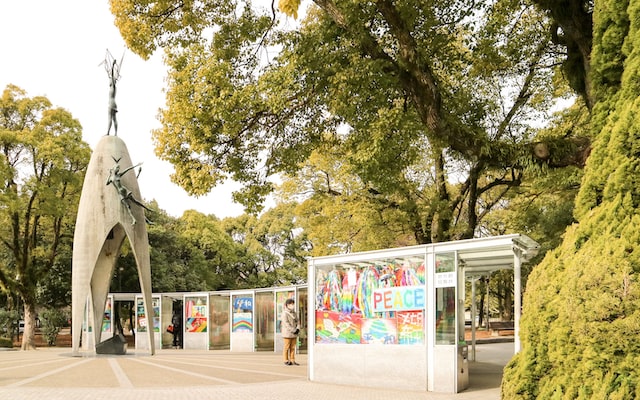
The park grounds
While the park is home to several notable museums and landmarks, even just strolling around its historic grounds will give you a good sense of the city’s history and lasting legacy. Also designed by Kenzo Tange, the park’s grounds showcase traditional Japanese aesthetics with a modern architectural style. The numerous sculptural expressions jutting out of strategic spots in the park grounds along with its functional aesthetics pave for profound introspection to the many visitors that want to experience the memorial in person.
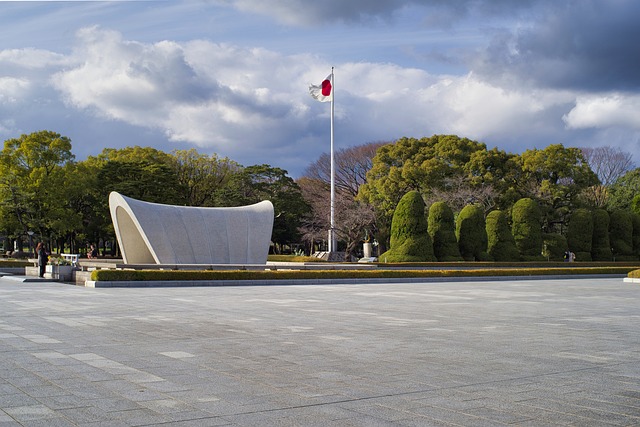
The grounds are at their most impressive during the Peace Memorial Ceremony. This annual memorial takes place on August 6. During this time, you can listen to inspiring speeches. Paper lanterns with messages of peace are also floated down the Motoyosu River.
An enduring legacy
Hiroshima Peace Memorial Park stands as a powerful symbol of the devastating impact of war and nuclear weapons, and a reminder of the urgent need for peace and reconciliation. The park’s enduring anti-war message is reflected in its many monuments, exhibits, and memorials, which tell the stories of the victims of the atomic bombing. Through its ongoing efforts to advocate for peace, it continues to inspire visitors from around the world to work towards a more peaceful future — truly a worthy stop when you get the chance to visit Japan.
